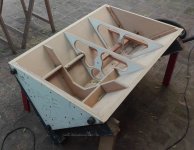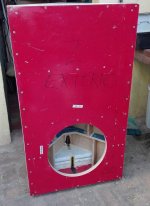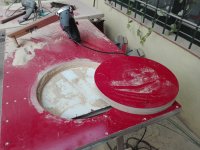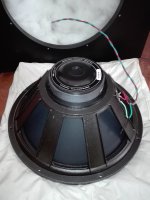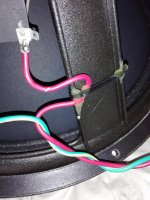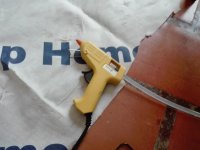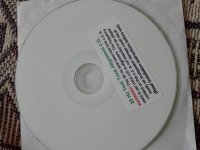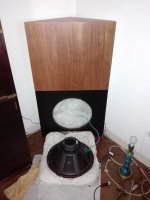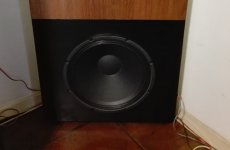As I am a bit of a perfectionist maniac and in these times of pandemic there is something to be entertained, I decided to solve a problem that probably was not such.
When I taped the wires to the weak speaker connection foil, I thought they might come loose, because the basket is slightly irregular in shape, and the plastic strips would slide into the narrower section with vibration. They had to be fixed permanently, but the extra task was forgotten.
So yesterday I decided to do it because by the way I wanted to do a little experiment, motivated by this recently read post.
https://www.diyaudio.com/forums/full-range/365242-softly-coupling-driver-cabinet.html
The photos explain the work done.
It was risky to get the speaker upright, but I had already discarded the "beds" I had made to work horizontally.
So I prepared a bracket to support the bottom of the speaker once it was loose, and there were no major inconveniences, thankfully.
And the heads of the fixing screws also had to be covered with black paint. Done. Now I like the look better.
Having said that, let's go to the experiment in the post. Let's agree that a sealed cabinet is not the same as a ventilated one, the internal air pressure inside the sealed cabinet is much higher, but the resonances transmitted from the speaker structure to the cabinet obey the same physical phenomena.
I had a concern to vary the setting of the set screws and observe what was happening with the vibration of the cabinet. Although the speaker is not fully floating, as would be the idea of the post mentioned, because the screws here are an important mechanical coupling, I wanted to see what happened.
I used a CD with a fixed 30 Hertz pitch.
Conclusions:
1) There is no variation in the resonance of the cabinet with the screws slightly tightened - just so that the gasket is sealed and air does not escape - or firmly tightened - as they were originally -.
2) At low volumes, the cabinet is "dead" across its entire surface. But oh, surprise! At high volumes, a slight vibration is perceived (by resting the hand on it) only in the upper part of the cabinet. From the middle of the cabinet to the floor, there is no vibration, it remains inert. With high volumes, well, the entire cabinets, the speaker and all the furniture shake. The walls reflect but do not resonate, they are made of solid material (bricks).
3) These tests and results make me think that the cross and vertical gussets do their job acceptably, but the thickness of the side walls and top panel (19mm) should have been thicker, perhaps 30mm like the front baffle. It is evident that the extra weight added to the base of the cabinet with marble blocks lowers the resonance (added to the weight of the speaker) in the area around the speaker effectively, as intended. But not as we move away from this area.
But either way, the resonances are well above the working passband of the subwoofer, which is crossover via an 80 Hertz DSP amplifier with an 18 dB / octave Butterwhort slope. In my next reincarnation I will see to make thicker panels and fill the entire interior with sheets of lead .....
Any thoughts and / or criticisms will be well received. Ahead. Come on ! 😀
PD: Rest of pics next post
When I taped the wires to the weak speaker connection foil, I thought they might come loose, because the basket is slightly irregular in shape, and the plastic strips would slide into the narrower section with vibration. They had to be fixed permanently, but the extra task was forgotten.
So yesterday I decided to do it because by the way I wanted to do a little experiment, motivated by this recently read post.
https://www.diyaudio.com/forums/full-range/365242-softly-coupling-driver-cabinet.html
The photos explain the work done.
It was risky to get the speaker upright, but I had already discarded the "beds" I had made to work horizontally.
So I prepared a bracket to support the bottom of the speaker once it was loose, and there were no major inconveniences, thankfully.
And the heads of the fixing screws also had to be covered with black paint. Done. Now I like the look better.
Having said that, let's go to the experiment in the post. Let's agree that a sealed cabinet is not the same as a ventilated one, the internal air pressure inside the sealed cabinet is much higher, but the resonances transmitted from the speaker structure to the cabinet obey the same physical phenomena.
I had a concern to vary the setting of the set screws and observe what was happening with the vibration of the cabinet. Although the speaker is not fully floating, as would be the idea of the post mentioned, because the screws here are an important mechanical coupling, I wanted to see what happened.
I used a CD with a fixed 30 Hertz pitch.
Conclusions:
1) There is no variation in the resonance of the cabinet with the screws slightly tightened - just so that the gasket is sealed and air does not escape - or firmly tightened - as they were originally -.
2) At low volumes, the cabinet is "dead" across its entire surface. But oh, surprise! At high volumes, a slight vibration is perceived (by resting the hand on it) only in the upper part of the cabinet. From the middle of the cabinet to the floor, there is no vibration, it remains inert. With high volumes, well, the entire cabinets, the speaker and all the furniture shake. The walls reflect but do not resonate, they are made of solid material (bricks).
3) These tests and results make me think that the cross and vertical gussets do their job acceptably, but the thickness of the side walls and top panel (19mm) should have been thicker, perhaps 30mm like the front baffle. It is evident that the extra weight added to the base of the cabinet with marble blocks lowers the resonance (added to the weight of the speaker) in the area around the speaker effectively, as intended. But not as we move away from this area.
But either way, the resonances are well above the working passband of the subwoofer, which is crossover via an 80 Hertz DSP amplifier with an 18 dB / octave Butterwhort slope. In my next reincarnation I will see to make thicker panels and fill the entire interior with sheets of lead .....
Any thoughts and / or criticisms will be well received. Ahead. Come on ! 😀
PD: Rest of pics next post
Attachments
The repaired
Attachments
Last edited:
The problem with unanswered posts (in addition to discouraging you to continue doing so) is that you do not know if you wrote a lot of nonsense or just the opposite, a correct reasoning that no one dares to refute. Too bad so much effort on my part over the years to contribute to the forum and not have answers, but this is so. Take it or leave.
Thanks all the same. Beware of Covid 19
Thanks all the same. Beware of Covid 19
Some of your thread lost me, but the conclusion thicker and heavier seem valid. Thicker than most assume.
Using just a single frequency for testing may cause you to miss something.
Using just a single frequency for testing may cause you to miss something.
Academia50,I used a CD with a fixed 30 Hertz pitch.
Conclusions:
1) There is no variation in the resonance of the cabinet with the screws slightly tightened - just so that the gasket is sealed and air does not escape - or firmly tightened - as they were originally -.
2) At low volumes, the cabinet is "dead" across its entire surface. But oh, surprise! At high volumes, a slight vibration is perceived (by resting the hand on it) only in the upper part of the cabinet. From the middle of the cabinet to the floor, there is no vibration, it remains inert. With high volumes, well, the entire cabinets, the speaker and all the furniture shake.
3) It is evident that the extra weight added to the base of the cabinet with marble blocks lowers the resonance (added to the weight of the speaker) in the area around the speaker effectively, as intended. But not as we move away from this area.
Don't feel you are alone 🙂
A fixed 30Hz tone tells little about a cabinet's resonance or vibration at other frequencies. Using pink noise or swept sine waves as a source would provide more useful information. That said, without some "before and after" measurements, an empirical resonance (vibration?) test provides virtually no useful information.
1)Slightly tightened screws will loosen after being subjected to vibration unless glued in place.
The black screws do look better!
2) Those results don't surprise me, especially since the heavy part of the cabinet with the vibration producing transducer is supported by flexible feet. Would you be surprised if you flipped the cabinet over and then found more vibration at the top?
3) What frequency was the resonance prior to the addition of marble blocks? What frequency was the resonance lowered to?
Art
Some of your thread lost me, but the conclusion thicker and heavier seem valid. Thicker than most assume.
Using just a single frequency for testing may cause you to miss something.
What is the paragraph that confused you? I'm sorry for my English ...
What would I want to test other frequencies for? (I could have used Audacity and tried various tones), but didn't see it necessary for a subwoofer that is built to operate from 40hz (the -3db limit of my satellites) down.
Academia50,
Don't feel you are alone 🙂
It is that there are many months of pandemic and when I warned about what was coming ...... if only they had listened to me !
😉
A fixed 30Hz tone tells little about a cabinet's resonance or vibration at other frequencies. Using pink noise or swept sine waves as a source would provide more useful information. That said, without some "before and after" measurements, an empirical resonance (vibration?) test provides virtually no useful information.
Same answer as tvrgeek ... I didn't think it was necessary ...
1)Slightly tightened screws will loosen after being subjected to vibration unless glued in place.
I agree, it was a test, they were tightened again according to my knowledge and understanding .... Troels related once that a guy tightened the basket with bolts and nuts so much that he twisted the bell of a speaker, I think it was made of cast aluminum, a JBL
The black screws do look better !
I think that deep down that is the answer that I wanted to hear, you have made me very happy !! Thanks a lot, Art 😉🙂
2) Those results don't surprise me, especially since the heavy part of the cabinet with the vibration producing transducer is supported by flexible feet.
No, the flex feet are gone, now they are solid wooden feet with plush
Last edited:
Would you be surprised if you flipped the cabinet over and then found more vibration at the top ?
I bet the vibration will be the same, higher in the less mass part
3) What frequency was the resonance prior to the addition of marble blocks? What frequency was the resonance lowered to?
Art
I ignore it
I never used them without the added weight .... and I think I will heed a suggestion from a member here who advised adding another block of marble in the exact shape of the upper triangle. Hey, I think it would look very classy!
Thanks Art, now I feel better.
Academia50,
Let's say MMs includes the cone, 1/2 the surround, 1/2 the spider,
and the voice coil. (I'm not sure if this is the true definition of MMs.)
I am referring to EVERYTHING that is moving.
EVERYTHING ELSE, including the driver frame and magnet AND the
enclosure, should have infinite mass. (You know what I mean.)
And it should be infinitely stiff.
That is the goal, in my opinion.
NOT de-coupling the basket from the enclosure.
If the enclosure is flimsy, strengthen it.
Adding lead is a good idea.
Let's say MMs includes the cone, 1/2 the surround, 1/2 the spider,
and the voice coil. (I'm not sure if this is the true definition of MMs.)
I am referring to EVERYTHING that is moving.
EVERYTHING ELSE, including the driver frame and magnet AND the
enclosure, should have infinite mass. (You know what I mean.)
And it should be infinitely stiff.
That is the goal, in my opinion.
NOT de-coupling the basket from the enclosure.
If the enclosure is flimsy, strengthen it.
Adding lead is a good idea.
It sounds like I see it, but why do you say 1/2?
The definition of Mms seems to be a bit more complex, there is a "confusing" part according to Eminence ....😕
Understanding Loudspeaker Data | Eminence Speaker
" MMS
This parameter is the combination of the weight of the cone assembly plus the ‘driver radiation mass load’. The weight of the cone assembly is easy: it’s just the sum of the weight of the cone assembly components. The driver radiation mass load is the confusing part. In simple terminology, it is the weight of the air (the amount calculated in Vd) that the cone will have to push."
The definition of Mms seems to be a bit more complex, there is a "confusing" part according to Eminence ....😕
Understanding Loudspeaker Data | Eminence Speaker
" MMS
This parameter is the combination of the weight of the cone assembly plus the ‘driver radiation mass load’. The weight of the cone assembly is easy: it’s just the sum of the weight of the cone assembly components. The driver radiation mass load is the confusing part. In simple terminology, it is the weight of the air (the amount calculated in Vd) that the cone will have to push."
Last edited:
MMS is the mass of MMD (Mass of the Moving parts of the Driver only) plus the weight of the air (the amount calculated in Vd) that the cone will have to push, Sd (Surface area of the cone) multiplied by Xmax.
Sd is the effective projected area of the cone or diaphragm, generally accepted as the cone body diameter plus one third to one half the width of the annulus (surround), as the outer portion of the annulus is stationary even at full excursion.
Mmd includes a portion of the weight of the surround and spider, but since the outer portion of both are stationary even at full excursion, some portion of that weight is not moving, so roughly half the weight of the surround and spider weight can be deducted.
Sd is the effective projected area of the cone or diaphragm, generally accepted as the cone body diameter plus one third to one half the width of the annulus (surround), as the outer portion of the annulus is stationary even at full excursion.
Mmd includes a portion of the weight of the surround and spider, but since the outer portion of both are stationary even at full excursion, some portion of that weight is not moving, so roughly half the weight of the surround and spider weight can be deducted.
I do not want to complicate the point with my poor command of the English language, so I prefer to copy and paste and take it for granted.
🙂
The TS parameters are not exact at this point, so .......
Definitions: Speaker Parameters.
" Effective Cone Area of the Driver – Sd
Speaker ParametersThis parameter describes the effective “size” of our speaker. We all realize that the cone will move air for us, but we also have to take into account the addition of the surround. It is commonly accepted that we can use a value of half the surround as contributing to the output of the driver. "
" Mass of the Cone and Moving Parts – Mms
The Mms specification describes the mass of the speaker cone and part of the spider and surround. Unlike the Mmd specification, Mms includes the acoustic load caused by the air in contact with the cone. In most cases, the values are similar, but as the surface area of the cone increases, so too does the value of Mms, relative to Mmd."
🙂
The TS parameters are not exact at this point, so .......
Definitions: Speaker Parameters.
" Effective Cone Area of the Driver – Sd
Speaker ParametersThis parameter describes the effective “size” of our speaker. We all realize that the cone will move air for us, but we also have to take into account the addition of the surround. It is commonly accepted that we can use a value of half the surround as contributing to the output of the driver. "
" Mass of the Cone and Moving Parts – Mms
The Mms specification describes the mass of the speaker cone and part of the spider and surround. Unlike the Mmd specification, Mms includes the acoustic load caused by the air in contact with the cone. In most cases, the values are similar, but as the surface area of the cone increases, so too does the value of Mms, relative to Mmd."
- Home
- Loudspeakers
- Subwoofers
- Empirical resonance testing and wire fixing on my DIY Subwoofers
